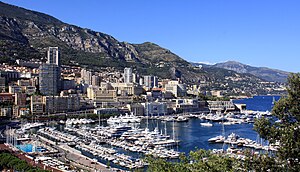
Monaco is known for its wide range of architecture for a small country.[1] The geography of Monaco, which consists of sharp hills and narrow coastline, influences the Monagasque architecture. The narrow roads have led to architectural construction being built into the hills in limited amounts of space.[2] This limited space has, more recently, the issue of construction in Monaco has created social disruption.[3]
The history of the architecture of Monaco can be predominantly attributed to its location on the South East of France, which has allowed strong French influence, especially that of the Belle Époque period.[4] Italian qualities can also be found due to proximity, Genoese heritage and the influence of the Capriccio movement, incorporated in the housing architecture of notable structures in Monte Carlo. Notable Monagasque works of French architects Charles Garnier[5] and Jules Dutrou[6] epitomise the mixture of other European and historical influences. Decorative features like coloured turrets, terraces and caryatids are distinct throughout Monte Carlo.[7] Modern Monégasque architecture is reflective of Mediterranean influence, with the predominantly used materials sourced locally; including granite, marble and terracotta tiles. The warm climate encourages outdoor living and provides an explanation for the prevalence of public squares and balconies throughout the country.[8]
- ^ "Geography of Monaco, Landforms - World Atlas". www.worldatlas.com. Retrieved 2019-05-12.
- ^ "The Opening of the Oceanographical Museum at Monaco". The Geographical Journal. 35 (5): 558–565. 1910. doi:10.2307/1777778. JSTOR 1777778.
- ^ Scott, Katy (2018-01-05). "Monaco's $2.3bn project to expand into Mediterranean Sea". CNN Style. Retrieved 2019-05-20.
- ^ Bairati, Eleonora. (1978) La Belle époque: fifteen euphoric years of European history. New York: W. Morrow.
- ^ "Charles Garnier | French architect". Encyclopedia Britannica. Retrieved 2019-05-12.
- ^ Casinokings (2017-05-18). "5 things you did not know about the Monte Carlo casino". Casino Kings Club. Retrieved 2019-05-12.
- ^ Harrison, Barry (1980). "Broad Street, its houses and residents through eight centuries". Vernacular Architecture. 11 (1): 21. doi:10.1179/vea.1980.11.1.21. ISSN 0305-5477.
- ^ "Architecture Apartments Balconies blinds Monte Carlo Monaco Editorial Stock Photo - Stock Image | Shutterstock". Shutterstock Editorial. Retrieved 2019-05-12.